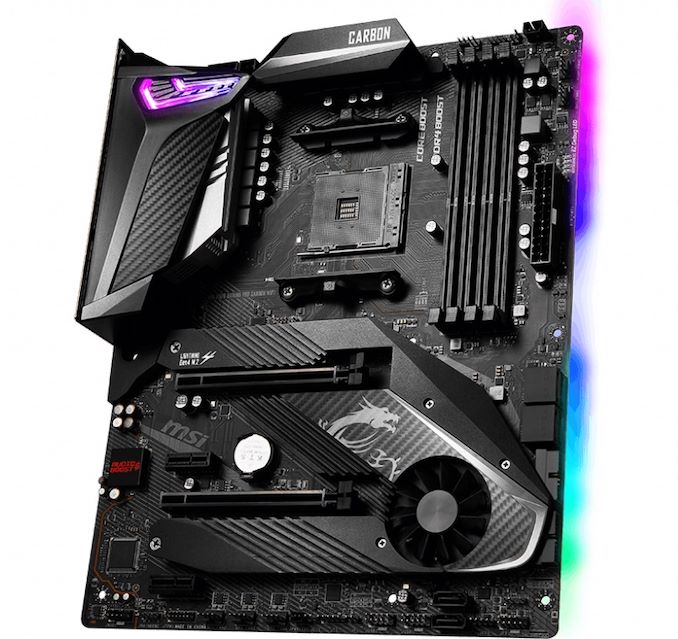The AMD X570 Motherboard Overview: Over 35+ Motherboards Analyzed
by Gavin Bonshor on July 9, 2019 8:00 AM ESTMSI MPG X570 Gaming Pro Carbon WIFI
The MSI MPG X570 Gaming Pro Carbon WIFI marks a shift from the company offering two versions of the same model: one with Wi-Fi and one without - this board is only available with Wi-Fi, This model represents its top tier gaming focused model, and its notable features include two PCIe 4.0 M.2 slots, a Realtek ALC1220 HD audio codec, Intel Gigabit NIC, and a Wi-Fi 6 802.11ax wireless interface.
On the aesthetic of the MSI MPG X570 Gaming Pro Carbon WIFI motherboard, it includes a black carbon inspired design with a uniformed X570 chipset heatsink with the two M.2 heatsinks fitting in well with the rest of the board. Both the PCIe 4.0 M.2 slots include their own individual M.2 heatshield and the Frozr chipset heatsink which includes a fan which means the X570 chipset is actively cooled. In the top right-hand corner of the PCB is four RAM slots with support for up to DDR4-4400 with up to 128 GB of capacity. In addition to the two PCIe 4.0 x4 M.2 slots, MSI has also included six SATA ports; four with right-angled connectors, and two straight-angled located directly below the chipset heatsink. Included are two full-length PCIe 4.0 slots which operate at x16 and x8/x4 which allows users to use two way AMD CrossFire multi-graphics configurations. There are also two additional PCIe 3.0 x1 slots.
MSI is using Intel's new AX200 802.11ax Wi-Fi adapter with speeds capable of up to 2.4 Gbps and antenna ports are included on the rear panel. The rear panel also includes three USB 3.1 G2 Type-A, one USB 3.1 G2 Type-C, two USB 3.1 G1 Type-A, and two USB 2.0 ports. Also on the rear panel is an HDMI video output for users looking to install a Ryzen based APU, a PS/2 combo port and a BIOS flashback button. This is in addition to an Intel I211-AT Gigabit NIC controlling the single Ethernet port.
The MSI MPG X570 Gaming Pro Carbon WIFI has an MSRP of $259 which puts it right into the mid-range market segment. With a range of features, an integrated Wi-Fi 6 802.11ax wireless interface and a neutral aesthetic, it looks pretty good. The only niggle is that other vendors for the same price are implementing better NICs such as Realtek's RTL8125 2.5 Gigabit NIC and based on that, other models could make more appeal. The MPG X570 Gaming Pro Carbon, however, is a no-frills and no fuss option for gamers to sink their teeth into.












225 Comments
View All Comments
DigitalFreak - Tuesday, July 9, 2019 - link
I think the only advantage of using a 2000 series CPU with an X570 board will be PCIe 3.0/4.0 support. The X370/X470 only supported PCIe 2.0. In theory, the connection from the 2000 processor to the X570 chipset should run at PCIe 3.0 speeds.FreckledTrout - Tuesday, July 9, 2019 - link
The x370 chipset and x470 both supported PCIe 3.0 with either a 1xxx or 2xxx Ryzen CPU. If you are not running a 3xxx CPU in the x570 board there isn't any major feature that should cause one to want to upgrade.DigitalFreak - Tuesday, July 9, 2019 - link
@FreckledTrout - Yes and no. The interconnect between the CPU and the chipset is PCIe 3.0 on X370 / X470, but all the PCIe lanes that come off the chipset are 2.0. Running a 2000 series CPU in an X570 board would give you a PCIe 3.0 link between the CPU and the chipset, with either PCIe 3.0 or 4.0 lanes coming off the chipset (depends on if AMD drops everything to PCIe 3.0 with a 2000 series processor).extide - Tuesday, July 9, 2019 - link
It looks like they still allow the chipset lanes to be 4.0. So you'd have 3.0 link to cpu, but 4.0 from chipset to devices.Targon - Thursday, July 11, 2019 - link
Since you have at least one or two PCI Express slots that are connected to the CPU, not chipset, that almost becomes a non-issue. On my Asus ROG Crosshair VI Hero(X370), you have PCI Express 3.0 x16 for the first slot, or x8/x8. The third PCI Express x16 slot is a 2.0 I believe, which is still enough to get the job done for many devices. Even with the X570 board with a first or second generation Ryzen processor, the most you end up with is an extra 3.0 supporting slot. Note that many boards may have x16 slots, but they are x8 electrically, so you won't see the full bandwidth anyway in those slots.sorten - Tuesday, July 9, 2019 - link
Thanks Gavin! This is a great resource and is exactly what I needed to help build my new system.willis936 - Tuesday, July 9, 2019 - link
The return of the 40mm fan! Those are the most obnoxious components ever. No one has missed them in the past ten years.Kastriot - Tuesday, July 9, 2019 - link
Buy Asrock aqua and problem solved.FreckledTrout - Tuesday, July 9, 2019 - link
I'm waiting for the next iteration of board for this reason. I'm speculating the next round the chipset will be on 7nm.abufrejoval - Tuesday, July 9, 2019 - link
The genious about that chiplet design is that the chipset doesn't actually benefit nearly as much from the shrink, as pure logic or SLC caches: The monolithic guys pay the 7nm overhead (e.g. EUV) for I/O while the geometry of the transistors in the I/O area is mostly determined by the need to power long motherbord or even slot traces.So while waiting is never a bad idea when your need clearly isn't overwhelming you, waiting for that shrink could turn out rather long. These days I/O heave chips might never be done in smaller geometries, because of that and because packaging has matured.